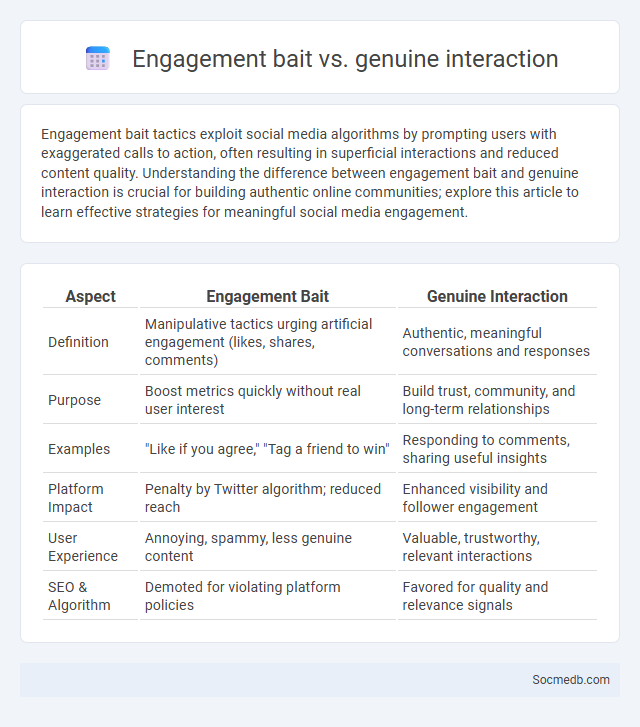
Photo illustration: Engagement bait vs Genuine interaction
Engagement bait tactics exploit social media algorithms by prompting users with exaggerated calls to action, often resulting in superficial interactions and reduced content quality. Understanding the difference between engagement bait and genuine interaction is crucial for building authentic online communities; explore this article to learn effective strategies for meaningful social media engagement.
Table of Comparison
| Aspect | Engagement Bait | Genuine Interaction |
|---|---|---|
| Definition | Manipulative tactics urging artificial engagement (likes, shares, comments) | Authentic, meaningful conversations and responses |
| Purpose | Boost metrics quickly without real user interest | Build trust, community, and long-term relationships |
| Examples | "Like if you agree," "Tag a friend to win" | Responding to comments, sharing useful insights |
| Platform Impact | Penalty by Twitter algorithm; reduced reach | Enhanced visibility and follower engagement |
| User Experience | Annoying, spammy, less genuine content | Valuable, trustworthy, relevant interactions |
| SEO & Algorithm | Demoted for violating platform policies | Favored for quality and relevance signals |
Understanding Engagement Bait: Definition and Examples
Engagement bait refers to social media posts deliberately designed to manipulate algorithms by encouraging users to like, share, comment, or react, often through emotionally charged prompts or calls to action such as "Tag a friend" or "Share if you agree." Examples include posts that ask for votes ("Like this if you love pizza!") or encourage users to comment with emoji responses to boost visibility artificially. Platforms like Facebook have implemented penalties against engagement bait tactics to prioritize authentic interactions and reduce spammy content in users' feeds.
What Constitutes Genuine Interaction Online?
Genuine interaction online consists of authentic engagement, meaningful conversations, and reciprocal communication that fosters trust and connection. Your participation should prioritize active listening, empathy, and consistent responses to build real relationships beyond superficial likes or comments. True social media engagement is characterized by thoughtful exchanges that contribute value and demonstrate sincerity.
The Psychology Behind Engagement Bait Tactics
Engagement bait tactics exploit human psychology by triggering emotional responses such as curiosity, fear of missing out, or social validation, which encourages users to like, share, or comment on posts. These strategies manipulate your desire for recognition and social connection, driving higher interaction metrics often at the cost of authentic engagement. Understanding these underlying psychological drivers helps you recognize and avoid superficial content designed solely to boost visibility.
Key Differences Between Engagement Bait and Genuine Interaction
Engagement bait tactics manipulate social media algorithms by prompting users to like, share, or comment without providing real value, often resulting in low-quality interaction and potential platform penalties. Genuine interaction, however, fosters meaningful connections through authentic content that encourages thoughtful conversations and builds trust within your audience. Understanding these key differences helps you create content that boosts organic reach and strengthens Your social media presence.
How Social Media Algorithms Respond to Engagement Bait
Social media algorithms detect engagement bait by identifying posts that explicitly ask for likes, comments, or shares, and consequently reduce their visibility to maintain content quality. Platforms like Facebook and Instagram use machine learning models to analyze interaction patterns, penalizing posts that artificially inflate engagement metrics. This adaptive response encourages authentic user interactions and helps prevent spammy or manipulative content from dominating users' feeds.
The Impact of Engagement Bait on User Trust
Engagement bait on social media platforms significantly undermines user trust by promoting low-quality interactions that prioritize algorithmic visibility over authentic communication. Studies reveal that repetitive use of engagement bait tactics leads to decreased credibility and diminished user experience, causing audiences to disengage from content creators employing such strategies. Platforms like Facebook have implemented algorithmic penalties to reduce the reach of engagement bait, aiming to restore genuine interaction and maintain user confidence.
Strategies for Encouraging Authentic Engagement
Strategies for encouraging authentic engagement on social media involve creating genuine, relatable content that resonates with your target audience's interests and values. You should foster meaningful conversations by asking open-ended questions and promptly responding to comments to build a loyal community. Consistently showcasing behind-the-scenes moments and user-generated content strengthens trust and encourages your followers to interact sincerely.
Case Studies: Brands Succeeding with Genuine Interaction
Successful brands like Starbucks, Nike, and Glossier demonstrate that genuine interaction on social media drives customer loyalty and engagement by prioritizing authentic conversations and user-generated content. Starbucks leverages personalized responses and community-building campaigns that resonate with diverse audiences, while Nike incorporates customer stories and real-time feedback into its social strategy, enhancing brand trust. Glossier's focus on transparent communication and user collaboration effectively boosts brand advocacy and social proof, illustrating the power of sincere engagement in digital marketing.
Risks and Penalties of Using Engagement Bait
Engagement bait on social media violates platform guidelines and can lead to reduced organic reach, account suspension, or permanent bans. Facebook and Instagram actively penalize content that asks for likes, shares, or comments in a manipulative manner, as this behavior disrupts authentic user interactions. Protecting Your account requires avoiding such tactics to maintain credibility and ensure compliance with social media policies.
Best Practices for Promoting Meaningful Online Conversations
Encouraging meaningful online conversations on social media requires fostering respectful dialogue by setting clear community guidelines and actively moderating discussions to prevent misinformation and harassment. Utilizing open-ended questions and prompt responses helps engage users in thoughtful exchanges while promoting diverse perspectives enhances depth and understanding within the community. Leveraging platform features like threaded comments, live video discussions, and polls can create interactive environments that support sustained, productive conversations.
 socmedb.com
socmedb.com